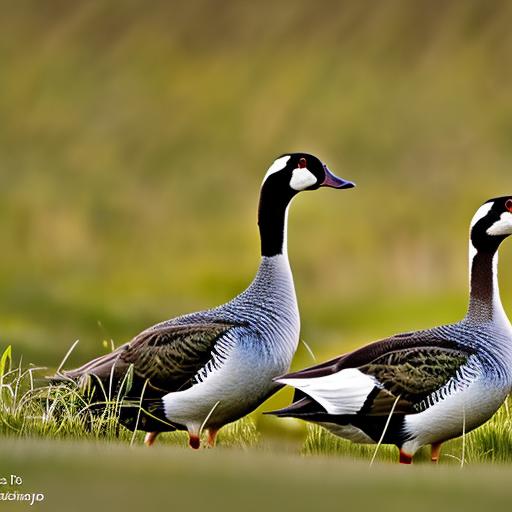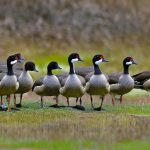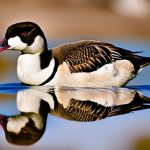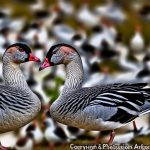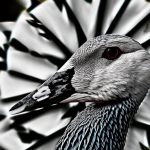Canadian geese are a common sight in many parts of North America, including Canada and the United States. While these birds may be beautiful to look at, they can also cause significant problems when their populations become too large. Canadian geese are known for their aggressive behavior, territorial nature, and ability to create unsightly messes with their droppings. As a result, effective management strategies are needed to control their populations and minimize the negative impact they can have on communities.
Key Takeaways
- Canadian geese are attracted to open spaces near water and grassy areas.
- Physical barriers such as fences and netting can prevent geese from accessing certain areas.
- Decoys that resemble predators can scare off geese.
- Sound or light deterrents can also be effective in deterring geese.
- Removing food sources and consistently maintaining your lawn can make your property less inviting to geese.
Understanding the behavior of Canadian geese
In order to effectively manage Canadian geese, it is important to understand their behavior and habits. These birds are highly adaptable and can thrive in a variety of environments, including urban areas. They are social animals that live in large flocks and are known for their strong family bonds. Canadian geese are also highly territorial and will aggressively defend their nesting sites and feeding areas.
One of the reasons why Canadian geese can be difficult to manage is their ability to remember and return to familiar locations year after year. They have excellent navigational skills and can travel long distances during migration. This means that simply relocating geese to another area is not an effective long-term solution.
Implementing physical barriers to deter geese
One method of managing Canadian geese is by implementing physical barriers to prevent them from accessing certain areas. This can include the installation of fences, netting, or hedges that create a physical barrier between the geese and the desired area. These barriers should be properly installed and regularly maintained to ensure their effectiveness.
Fences should be at least three feet high and have a top that slopes outward to prevent geese from perching on them. Netting can be used to cover bodies of water or other areas where geese may congregate. Hedges can also be effective in creating a visual barrier that discourages geese from entering an area.
Using decoys to scare off geese
Another method of managing Canadian geese is by using decoys to scare them off. Decoys can include fake predators, such as coyotes or owls, or other animals that geese perceive as a threat. These decoys should be placed strategically and moved regularly to maximize their effectiveness.
Decoys should be placed in areas where geese are likely to congregate, such as near water sources or feeding areas. They should be moved regularly to prevent geese from becoming accustomed to their presence. It is also important to choose decoys that are realistic and lifelike in order to effectively scare off geese.
Installing sound or light deterrents
Sound or light deterrents can also be effective in managing Canadian geese. These deterrents can include sirens, strobe lights, or lasers that create a loud noise or bright light that scares off geese. It is important to choose the right type of deterrent for the specific situation and to use them consistently.
Sound deterrents should be loud enough to startle geese but not so loud that they cause harm or distress to other animals or humans. Light deterrents should be bright enough to create a visual disturbance for the geese. It is important to regularly maintain and test these deterrents to ensure their effectiveness.
Creating an uninviting environment for geese
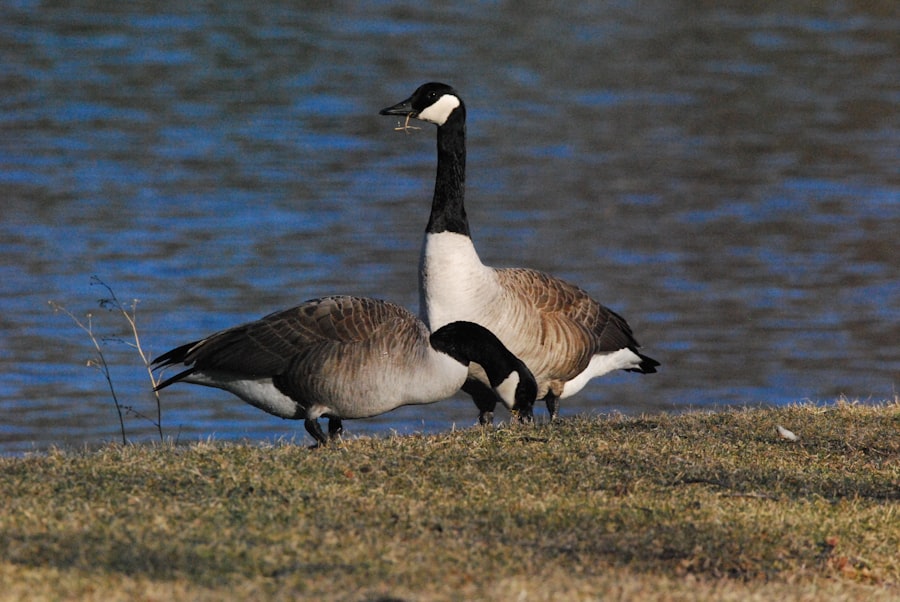
Creating an uninviting environment for geese is another effective management strategy. This can be done by removing attractive features such as water sources or shelter that may encourage geese to settle in an area. It is important to consistently maintain the area to prevent it from becoming attractive again.
Water sources, such as ponds or lakes, can be modified by adding floating devices or fountains that create movement and make it difficult for geese to land or swim. Shelter, such as tall grasses or shrubs, can be trimmed or removed to eliminate hiding places for geese. It is important to regularly monitor and maintain the area to ensure that it remains uninviting to geese.
Removing food sources that attract geese
Food sources are a major attractant for Canadian geese, so removing these sources can help manage their populations. This can include removing grass clippings, fallen fruit, or other food items that geese may feed on. It is important to educate others in the community about the importance of removing these food sources as well.
Grass clippings should be bagged and disposed of properly instead of being left on the lawn. Fallen fruit should be promptly picked up and discarded. It is also important to discourage feeding geese intentionally, as this can encourage them to stay in an area.
Consistently maintaining your lawn and landscape
Consistently maintaining your lawn and landscape is another important aspect of managing Canadian geese. Geese are attracted to well-maintained lawns and landscapes that provide ample grazing opportunities. Proper mowing, pruning, and fertilization can help prevent geese from finding attractive areas to settle.
Mowing the lawn regularly and keeping it at a height of three inches or higher can make it less appealing to geese. Pruning trees and shrubs can eliminate perching or nesting sites for geese. Fertilizing the lawn properly can promote healthy growth and reduce the amount of available food for geese.
Seeking professional help for geese removal
In some cases, other methods of managing Canadian geese may not be effective, and professional help may be needed. Professional wildlife removal services can provide humane and effective solutions for managing geese populations. It is important to choose a reputable service that has experience in dealing with geese and follows ethical practices.
Professional wildlife removal services may use methods such as trapping and relocating geese or using trained dogs to scare them off. It is important to work with professionals who prioritize the well-being of the geese and follow local laws and regulations.
Educating your community on geese management
Educating others in the community on effective geese management strategies is crucial for long-term success. This can include sharing information about the habits and tendencies of Canadian geese, as well as the various methods available for managing their populations. It is important to work together as a community to prevent geese from becoming a problem.
Community education can be done through workshops, presentations, or informational materials. It is important to emphasize the importance of consistent maintenance and removal of food sources to prevent geese from settling in an area. By educating others, you can create a more informed and proactive community that is better equipped to manage geese populations.
Adhering to local laws and regulations for geese control
When implementing geese management strategies, it is important to adhere to local laws and regulations to prevent legal issues. Different jurisdictions may have specific rules regarding the removal or relocation of Canadian geese. It is important to research and understand these laws before implementing any management strategies.
Local wildlife agencies or environmental departments can provide information on the specific laws and regulations in your area. By following these guidelines, you can ensure that your efforts to manage Canadian geese are legal and ethical.
In conclusion, effective management strategies are needed to control Canadian geese populations and minimize their negative impact on communities. Understanding the behavior of Canadian geese is crucial for implementing effective management strategies. This can include using physical barriers, decoys, sound or light deterrents, creating an uninviting environment, removing food sources, consistently maintaining the lawn and landscape, seeking professional help when needed, educating the community, and adhering to local laws and regulations. By implementing these strategies, communities can successfully manage Canadian geese populations and create a more harmonious environment for both humans and wildlife.
If you’re looking for effective ways to keep Canadian geese off your grass, you might also be interested in learning about how guinea fowl can help with pest control. Guinea fowl are known for their ability to deter unwanted pests, including geese, due to their loud calls and aggressive behavior. To find out more about whether guinea fowl can live with chickens and how they can be beneficial in keeping your property free from geese, check out this informative article on poultrywizard.com.
FAQs
What are Canadian geese?
Canadian geese are a species of waterfowl that are native to North America. They are known for their distinctive black heads and necks, white cheeks, and brown bodies.
Why do Canadian geese come onto my grass?
Canadian geese are attracted to grassy areas because they provide a source of food and a place to rest. They are also attracted to bodies of water, which are often found near grassy areas.
Are Canadian geese dangerous?
Canadian geese are generally not dangerous to humans, but they can become aggressive if they feel threatened or if they are protecting their young. They can also carry diseases that can be transmitted to humans.
How can I keep Canadian geese off my grass?
There are several methods that can be used to keep Canadian geese off your grass, including installing fencing or netting, using decoys or scare tactics, and modifying the landscape to make it less attractive to geese.
Is it legal to harm Canadian geese?
No, it is illegal to harm Canadian geese under the Migratory Bird Treaty Act. However, there are certain exceptions that allow for the removal of geese under certain circumstances, such as when they pose a threat to public health or safety.
Meet Walter, the feathered-friend fanatic of Florida! Nestled in the sunshine state, Walter struts through life with his feathered companions, clucking his way to happiness. With a coop that’s fancier than a five-star hotel, he’s the Don Juan of the chicken world. When he’s not teaching his hens to do the cha-cha, you’ll find him in a heated debate with his prized rooster, Sir Clucks-a-Lot. Walter’s poultry passion is no yolk; he’s the sunny-side-up guy you never knew you needed in your flock of friends!

